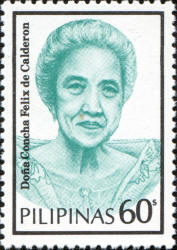Concepción Felix facts for kids
Quick facts for kids
Concepción Felix
|
|
|---|---|
 |
|
| Born |
Concepción Felix Roque
9 February 1884 Tondo, Manila, Captaincy General of the Philippines, Spanish Empire
|
| Died | 26 January 1967 (aged 82) |
| Nationality | Filipino |
| Other names | Concepción Felix de Calderón, Concepción Felix de Rodriguez, Concha Felix de Calderón, Concepción Felix-Rodriguez |
| Occupation | social worker, suffrage activist |
| Years active | 1905–1940 |
| Spouse(s) | Felipe Gonzáles Calderón Roca (m. 1907) Domingo Rodriguez (m. 20 June 1929) |
Concepción Felix Roque (born February 9, 1884 – died January 26, 1967) was a brave Filipina woman. She was a feminist and an activist for human rights. She helped start some of the very first groups for women in the Philippines. One of these was the Asociación Feminista Filipina. She also created a group called La Gota de Leche. This group helped mothers and their babies. Concepción often spoke to lawmakers. She wanted women to have the right to vote. She is known as one of the first feminists in the Philippines. She received many awards for her important work.
Contents
Early Life and Education
Concepción Felix Roque was born in Tondo, Manila, Philippines. Her birthday was February 9, 1884. Her parents were Juana Roque and Mauricio Felix. When she was six, she started school. She went to a private school run by Margarita Lopez. In 1893, she moved to a new school. It was called Assumption Convent.
After finishing her first studies, Concepción went to the Instituto de Mujeres. This means "Women's Institute." There, she earned a degree to become a teacher. She kept studying while teaching math. In 1904, she earned her bachelor's degree. Later, she studied law at the Escuela de Derecho. This was a law school in Manila. Felipe Gonzáles Calderón Roca started this school. He was also her private tutor. Concepción was one of the first four women allowed into this law school. She also became one of the first women to join the bar association. This meant she could practice law.
Fighting for Women's Rights
Starting Women's Groups
In 1905, Concepción started a group. It was called the Asociación Feminista Filipina. This means "Feminist Association of the Philippines." It was a volunteer group. They wanted to make things better for women and children. This included changes in prisons and workplaces. The group also worked to improve morals. They gave talks in schools and factories. These talks were about hygiene, health, and how to care for babies. They also wanted women to be part of local school boards. At this time, Concepción was not yet asking for women to vote.
Concepción knew that women did not have full legal rights. So, she got help from some male doctors. Together, they started a non-profit group. It was called La Protección de la Infancia, Inc.. Through this group, Concepción started La Gota de Leche in 1907. This was the first group focused only on mothers and children. Concepción wanted to create a small maternity ward. Here, nurses could be trained. They would also give clean milk to sick and weak babies. By 1909, the group was very successful. They needed a bigger place. Concepción led a fundraising effort. They raised money to buy equipment for the new facility.
The Fight for Women's Vote
In 1912, a famous woman named Carrie Chapman Catt visited. After her visit, Concepción and Pura Villanueva Kalaw joined other women. They formed a group called the Society for the Advancement of Women. At first, these women were not fully focused on voting rights. But they were building a strong base. They worked on community and social programs. Slowly, the women became more involved in politics. By 1920, getting women the right to vote was a main goal.
That year, Concepción was one of three Filipina women. They spoke to lawmakers. They gave them a petition signed by 18,000 women. This petition asked for women's right to vote. In 1933, a law was passed. It gave women the right to vote. But because of a new government, the process had to start again.
Concepción kept fighting. She worked with other strong women. These included Pilar Hidalgo-Lim, Josefa Llanes Escoda, Maria Paz Mendoza-Guazon, Constancia Poblete, and Pura Villanueva Kalaw. They pushed for women's voting rights. This happened during the 1934 Philippine Constitutional Convention. The 1935 Constitution said women could vote. But only if 300,000 qualified women agreed in a special vote. This special vote happened on April 30, 1937. It was called the Philippine women's suffrage plebiscite. It was a huge win for women!
Personal Life and Legacy
Concepción Felix married Felipe Calderón in 1907. They had one daughter named Concepción Calderón. Felipe died in 1908. Concepción then married Domingo Rodriguez on June 20, 1929. They did not have any children together.
Concepción Felix died on January 27, 1967.
Awards and Honors
Concepción Felix-Rodriguez received many awards for her work. In 1948, she got the Republic Medal of Merit. She also received a diploma of honor. The next year, UNESCO recognized her for her human rights work. In 1956, Pope Pius XII gave her the Pro Ecclesia et Pontifice award. This was for her work with the Catholic Women's League.
Concepción was the first person to get the Josefa Llanes Escoda Medal. This award was created by the National Federation of Women's Clubs. She was also the first to receive the Carrie Chapman Catt Award. This came from the Manila Women's Club. In 1966, during Women's Rights Day, Ferdinand Marcos gave her the Presidential Medal. In 1984, a special stamp was made with her picture on it.
See also
 In Spanish: Concepción Felix para niños
In Spanish: Concepción Felix para niños

